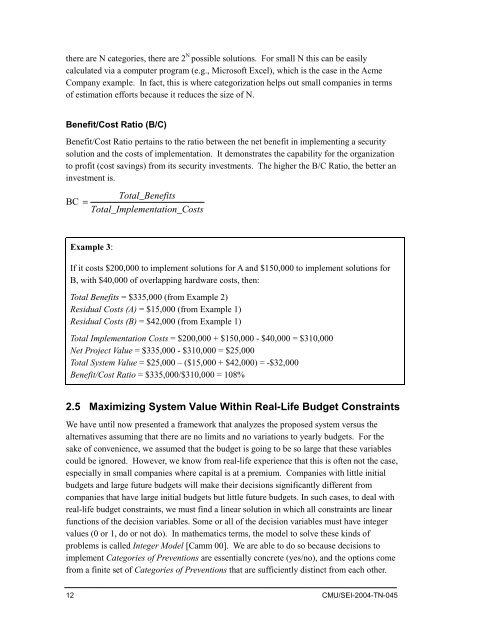SQUARE Project: Cost/Benefit Analysis Framework for Information ...
SQUARE Project: Cost/Benefit Analysis Framework for Information ...
SQUARE Project: Cost/Benefit Analysis Framework for Information ...
Create successful ePaper yourself
Turn your PDF publications into a flip-book with our unique Google optimized e-Paper software.
there are N categories, there are 2 N possible solutions. For small N this can be easily<br />
calculated via a computer program (e.g., Microsoft Excel), which is the case in the Acme<br />
Company example. In fact, this is where categorization helps out small companies in terms<br />
of estimation ef<strong>for</strong>ts because it reduces the size of N.<br />
<strong>Benefit</strong>/<strong>Cost</strong> Ratio (B/C)<br />
<strong>Benefit</strong>/<strong>Cost</strong> Ratio pertains to the ratio between the net benefit in implementing a security<br />
solution and the costs of implementation. It demonstrates the capability <strong>for</strong> the organization<br />
to profit (cost savings) from its security investments. The higher the B/C Ratio, the better an<br />
investment is.<br />
BC<br />
=<br />
Total_<strong>Benefit</strong>s<br />
Total_Implementation_<strong>Cost</strong>s<br />
Example 3:<br />
If it costs $200,000 to implement solutions <strong>for</strong> A and $150,000 to implement solutions <strong>for</strong><br />
B, with $40,000 of overlapping hardware costs, then:<br />
Total <strong>Benefit</strong>s = $335,000 (from Example 2)<br />
Residual <strong>Cost</strong>s (A) = $15,000 (from Example 1)<br />
Residual <strong>Cost</strong>s (B) = $42,000 (from Example 1)<br />
Total Implementation <strong>Cost</strong>s = $200,000 + $150,000 - $40,000 = $310,000<br />
Net <strong>Project</strong> Value = $335,000 - $310,000 = $25,000<br />
Total System Value = $25,000 – ($15,000 + $42,000) = -$32,000<br />
<strong>Benefit</strong>/<strong>Cost</strong> Ratio = $335,000/$310,000 = 108%<br />
2.5 Maximizing System Value Within Real-Life Budget Constraints<br />
We have until now presented a framework that analyzes the proposed system versus the<br />
alternatives assuming that there are no limits and no variations to yearly budgets. For the<br />
sake of convenience, we assumed that the budget is going to be so large that these variables<br />
could be ignored. However, we know from real-life experience that this is often not the case,<br />
especially in small companies where capital is at a premium. Companies with little initial<br />
budgets and large future budgets will make their decisions significantly different from<br />
companies that have large initial budgets but little future budgets. In such cases, to deal with<br />
real-life budget constraints, we must find a linear solution in which all constraints are linear<br />
functions of the decision variables. Some or all of the decision variables must have integer<br />
values (0 or 1, do or not do). In mathematics terms, the model to solve these kinds of<br />
problems is called Integer Model [Camm 00]. We are able to do so because decisions to<br />
implement Categories of Preventions are essentially concrete (yes/no), and the options come<br />
from a finite set of Categories of Preventions that are sufficiently distinct from each other.<br />
12 CMU/SEI-2004-TN-045
















